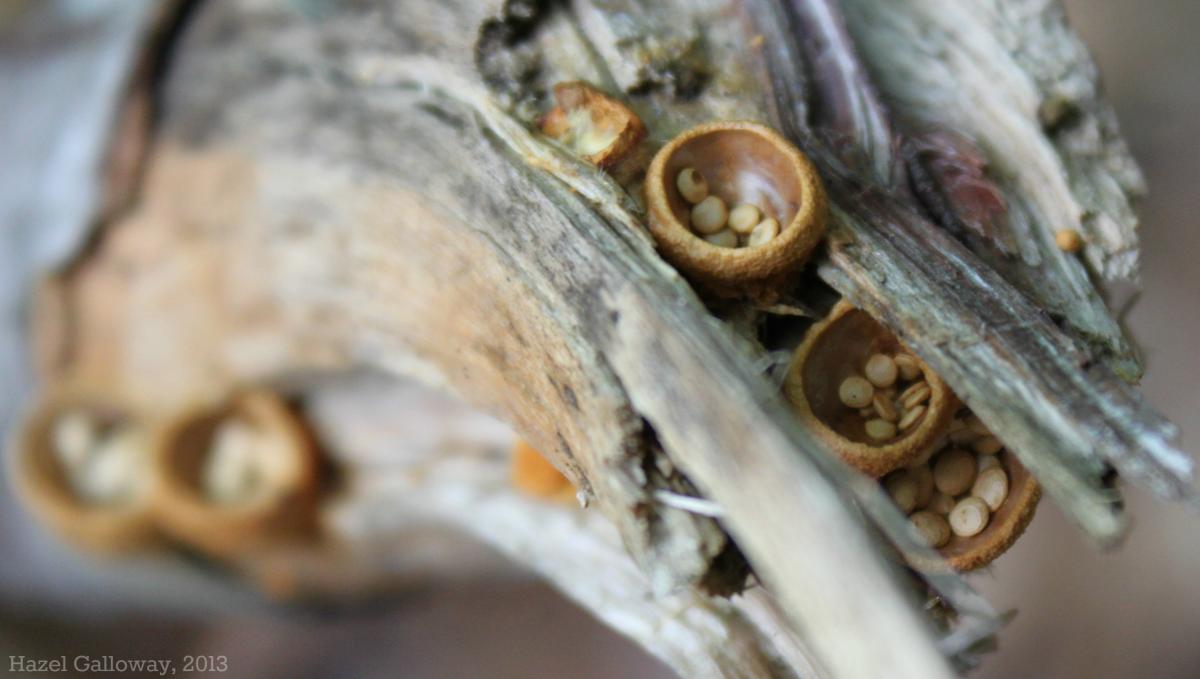 The cuban bee hummingbird holds the record for building the smallest bird’s nest in the world, measuring only two centimeters wide and three deep. With the largest specimens measuring about half that size, these fungi are remarkable miniature models which serve a purpose not entirely different from their avian-built counterparts.
The cuban bee hummingbird holds the record for building the smallest bird’s nest in the world, measuring only two centimeters wide and three deep. With the largest specimens measuring about half that size, these fungi are remarkable miniature models which serve a purpose not entirely different from their avian-built counterparts.
The bird’s nests that appear aboveground are the fruiting bodies of the underground fungal mycleium. They typically appear after damp periods, when the spores they produce will have the greatest chance of success in germination. When they first appear, each cup is covered by a tiny lid and they are easy to confuse with miniature puffballs. Upon maturing, however, they loose their lids and the “eggs” within are revealed. The outer surface of the nest is yellowish to brownish and has a velvety texture (but not shaggy, as in some other species). The inner surface is a whitish to greyish color and it smooth and shiny. Unlike many similar species, there are no vertical, radial grooves on the interior of the nest. The eggs, properly called “peridioles,” are pale or white. It is one of the only species of bird’s nest fungi in our area to produce eggs that are not dark-colored.
The structure of the bird’s nest fungus is serves a simple but extremely specific function in dispersing its spores as effectively as possible. Each peridiole is connected to the nest by a long, thin cord called a “funiculus.” When a raindrop falls in the nest, the eggs are projected out of the nest high into the air (see video, link below). Some species of bird’s nest fungi have been known to catapult the eggs well over two meters away. This stretches the funiculus to its breaking point, and it snaps at the end nearest the nest. The frayed ends of the cord are sticky, and adhere to the first object that they come in contact with. When the cord catches on some overhanging stick or leaf, the egg’s flight is halted, and it swings back towards the object and attaches itself there as well. From its new vantage point, the periodole releases the spores contained within it as the outer walls deteriorate over time. The spores are carried off by the wind or settle on the ground near the egg’s resting place. Like a real bird’s nest, these tiny splash cups are the location for the development of the organism’s offspring, and a crucial structure in their dispersal.
Unlike most fungi, it is not necessary for bird’s nest fungi to produce huge numbers of their spores so that two mycelium from different individuals will chance to fuse underground, become diploid, and complete the life cycle. Instead, they are dikaryotic—each spore already contains two nuclei, each derived from a different parent—and they are capable of producing fruiting bodies of their own as soon as they establish their mycleium in the substrate.
These fungi are saprobic (they obtain energy from decomposing organic matter) and can be found on alone, scattered, or in large groups on woodland debris. These fungi came from a dense cluster found on the edge of the Lower Jungle Trail-Indian Trail connector at the hotel, and were growing on leaves and dead sticks. This species is widely distributed across North America.
Hazel Galloway
Sources:
- Arora, David. Mushrooms Demystified. Berkeley: Ten Speed Press, 1986.
- www.mushroomexpert.com/crucibulum_laeve.html



